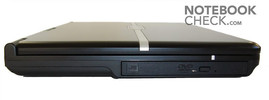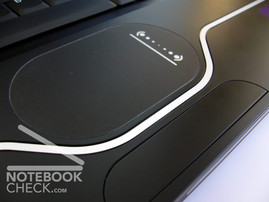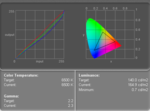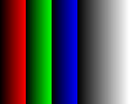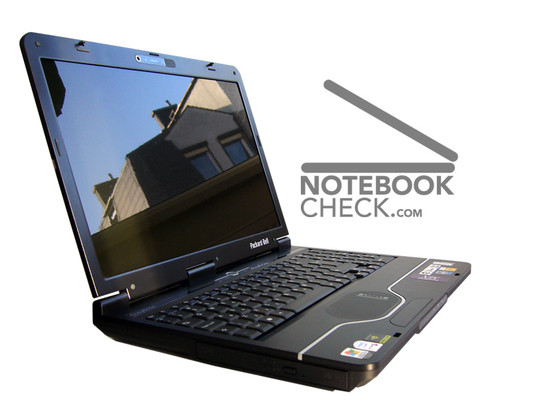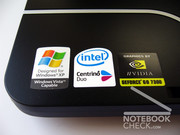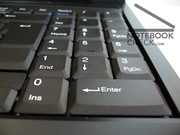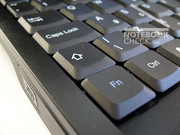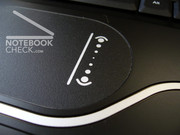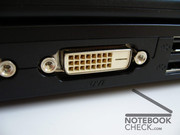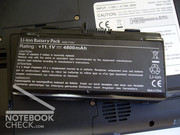Packard Bell EasyNote MX65-100
Case
The EasyNote MX65-100 looks quite neat. The silver line, which halves the outside of the lid, gives an agile feel to its appearance. Together with an illuminated Packard Bell logo in the middle, the whole machine might seem as a post-modern, industrial laptop. Which isn't a bad thing, is it? The company emblem, which is glowing in the dark, is a spectacular gizmo, reminding special light effects known from Dell.
After opening the lid things are still as interesting. The motive of the silver line has been repeated, except that the line is bent, encircling the bottom of the touchpad's plate. The design of the base unit's top panel is perhaps a little infantile, but certainly not routine (its extravagance doesn't apply to do keyboard unit, which is as ordinary as it can get).
The plastics used to manufacture MX65-100 are not of the highest quality, but it is no crap material either. All the elements are precisely fitted. The base unit is sufficiently rigid. It creaks only if one grabs it between fingers and clenches the right hand rest area. More serious reservations should be applied to the lid, which bends under pressure in the middle.
The closing mechanism, comprising two hooks, works flawlessly. The lid opens easily and the hinges move smoothly. However, when adjusting the screen to a suitable position, one has to wait a moment in order for the lid to stop swinging or hold it still.
The interfaces are assembled on the rear and on the right side only. On the back there are S-video, VGA out and a DVI-D connector, two USB 2.0 ports, RJ-45 (LAN) and modem sockets, as well as Kensington Lock. The power outlet is positioned right in the middle of the back panel. This location can prove inconvenient (especially so, as the socket is indistinctive). On the right side there are audio sockets, two more USB ports, IEEE 1394 and Express Card sockets and a 4-in-1 Memory Card Reader.
Input devices
The EasyNote MX65-100 possesses a numerical keyboard block, which is a rare thing among notebooks. Its presence will definitely please accountants, tax consultants and the like. Regular people will be glad to see additional Enter and Del key (since the main one is miniature). A serious inconvenience is a diminutive left shift key. The right one, on the other hand, is too large. The arrow keys are very much on the small side, so using the three bottom ones can be hindered, as the fingers knock on the verge of the base unit's panel.
The keys' characteristics are pretty much standard. In our view, the travel is a bit to long for swift typing, but it is a matter of predilection. The keyboard unit has been implanted in the base unit reliably enough, in order not to observe any bending whatsoever.
The touchpad of Packard Bell gives much less to cheer about. One has to admit that its round lines look quite nice (although some users might find excessive simplicity of its design repulsive). But that's just about it, as the positives go. The surface of the pad has feeble sliding characteristics. Therefore the device is little precise. The button (which is divided in half for two clicking areas) is quite distant from the pad itself, so it is uncomfortable in use. It is quite rough and resisting, so one has to really exert oneself and be unambiguous in one's intentions to achieve a click, which, after all, is often needed right away. The dead zone at center is quite large (the whole button, by the way, is exceptionally big). It is particularly difficult to push the button in darkness, when one gropes for it. To find it in such circumstances is quite a feat, because one instinctively looks for it right under the pad. Over there, however, lies only the silver line. This problem should disappear with time, as one gets accustomed to this laptop for good. So, the touchpad is one of the biggest drawbacks of EasyNote, but one can live with it. Especially if you consider it has a scrolling function to boot.
There are only two additional buttons, but they're very useful. One of them is responsible for switching on the WLAN module, the other one manages the Eco function (which is enormously helpful: it brightens the screen when it is completely dimmed - which comes in handy when we're downloading files from the Internet and would like to check the progress of the process from time to time; while at full brightness it reduces it in order to save energy). They neighbor in the middle above the keyboard on the power switch, but it is nearly impossible to confuse them, while the power button is round and the additional keys are rectangular.
Interesting feature: When, after closing the lid (incidentally or on purpose), the operating computer goes into hibernation mode, the blue status LED at the front edge of the base unit begins to pulse in slow motion, imitating the heartbeat of a sleeping living creature (Apple greets).
Display
Although the 15,4" WXGA Diamond View screen with a resolution of 1280x800 pixels is much celebrated, it hasn't particularly thrilled us. Seen with a naked eye, the image was nothing special. Once we've put our testing instrument into operation, however, it has showed some good values. The maximum brightness amounted to 168.8 cd/m², which is decent. The illuminating of 82.5% has to be regarded as very good. It means that the brightness is very much the same in all the areas of the screen. The maximum contrast has reached a 241:1 ratio. Not bad. Packard Bell did fall miserably, however, when it did come to judge its viewing angles. They're very narrow - as well in the vertical as in the horizontal range.
| |||||||||||||||||||||||||
Brightness Distribution: 83 %
Contrast: 236:1 (Black: 0.7 cd/m²)
Performance
The main hardware components of EasyNote MX65-100 are Intel Core Duo T2050 processor, GeForce Go 7300 graphic solution, and 1GB of operating memory. In comparison with other laptops reviewed at Notebookcheck.net up until now, such a set ranks not very high. Having this in mind, one has to say, that the efficiency tests went surprisingly well for Packard Bell.
Particularly the PCMark test was a success. Things weren't as rosily in case of the 3DMark, but one has to remember, that GeForce Go 7300 is a representative of the 4th category of graphic cards (see our Comparison of Graphic Cards).
The Packard Bell will manage some older games, and can render more up-to-date titles, albeit with some difficulties, no question. Thus, we can try to launch Unreal Tournament (with 40.9 fps), but will have to give up thoughts of playing Quake 4 (it's no fun at 12.6 fps only).
| 3DMark 2001SE Standard | 7430 points | |
| 3DMark 03 Standard | 2515 points | |
| 3DMark 05 Standard | 1296 points | |
| 3DMark 06 Score Unknown Setting | 542 points | |
Help | ||
| PCMark 04 Standard | 4388 points | |
| PCMark 05 Standard | 2922 points | |
Help | ||
Emissions
Volume
EasyNote MX65-100 would be fairly quiet, if not the fact, that the fan unwinds from time to time quite heavily. It works non-stop, but its sound isn't troublesome at all, as it reminds of water humming in a radiator. It speeds up, when the graphic card is in much use. Hence, the problem of noise boils down to the realms of multimedia and entertainment.
Measured sound levels:
Environment: 31.5dB
Idle, normal exhaust: 37dB
Normal exhaust + HDD: 38dB
Load, fan on maximum: 45dB
DVD rendition: 52dB
Warmth
PB heats up quite considerably, but the temperature stays within reasonable limits. One encounters this phenomenon especially during playing games, so no wonder that the highest temperatures were measured close to the graphic card (a the right hand side of the base unit around its joint with the lid). If one has to deal with the maximums of 40 degrees on the top and 42 at the bottom, there is no need to worry.
The Power supply pack, on the other hand, has heated up unusually strong. With 52.5 degrees registered on top it can get bothersome.
Upper side
palmwrist: 33.0°C max: 40.2°C avg: 34.1°C
Bottom side
max: 40.3°C avg: 35.3°C
Speakers
Were not bad, but we've expected a little more, considering the fact that PB has a subwoofer on board. The sound system doesn't impress with the amplitude of its power.
Battery runtime
Packard Bell works relatively long without the external source of power. Especially, if we consider the fact that the battery pack mounted in it has only a mere 4800 mAh capacity. Almost four hours of working with text documents is a decent result. One has to wonder, why the length of work with full load is shorter than that of DVD rendition by quite a large margin. Probably, the cause of it are speakers, which are not used during BatteryEater test.
BatteryEater Classic (full load): 2h 20min
BatteryEater Reader's (without load, min. brightness, no WLAN): 3h 55 min
DVD playback: 2h 4min
Current consumption
minimal (all off or at minimum): 16 W
+ max brightness: 25 W
+ WLAN: 27 W
maximal (full load including WLAN): 48 W
DVD rendition: 33 W
Verdict
Packard Bell EasyNote MX65-100 is quite a good laptop if you consider the value/price ratio. While its producer is underestimated, however, it has a tough job working his way through the stiff, more reputable competition.
In our view Packard Bell does not differ in quality aspects from mainstream, low-end notebooks such as HP, Asus or Toshiba. Well, it tends to surpass them in many ways.
Its strong points are pretty quiet operation, the rigidness of the base unit, diligent workmanship and quite good components, which don't exclude gaming experience. If not for appalling viewing angles, one would be also obliged to praise the Diamond View screen, which gives very bright and rich colors and has pretty good parameters of brightness, illumination and contrast. Many may find plausible the unusual but pleasing design of PB.
The biggest shortcoming of this notebook is its little functional touchpad. You can clearly see that the form took the better of the matter in that case. But this is not a dismal flaw, by any means. The more inconvenient drawback of the EasyNote MX65-100 are miserable viewing angles of the screen. They determine that this notebook can't be considered a multimedia laptop, while you can't watch the movie with a bunch of friends or family members (unless you resort to a external monitor, which is very much possible). What's more, the DVD drive is very loud during DVD rendition.
Having right proportions in mind, one can claim that Packard Bell offers quite a lot for the amount of money one has to spend on it. Therefore, in our view, it looks rather favorably in comparison to its rivals.
We'd like to thank Sirius.pl, for delivering us the equipment we've put to the test.


 Deutsch
Deutsch English
English Español
Español Français
Français Italiano
Italiano Nederlands
Nederlands Polski
Polski Português
Português Русский
Русский Türkçe
Türkçe Svenska
Svenska Chinese
Chinese Magyar
Magyar
